LINCOLN MKZ 2013 Owner's Manual
Manufacturer: LINCOLN, Model Year: 2013, Model line: MKZ, Model: LINCOLN MKZ 2013Pages: 474, PDF Size: 3.79 MB
Page 21 of 474
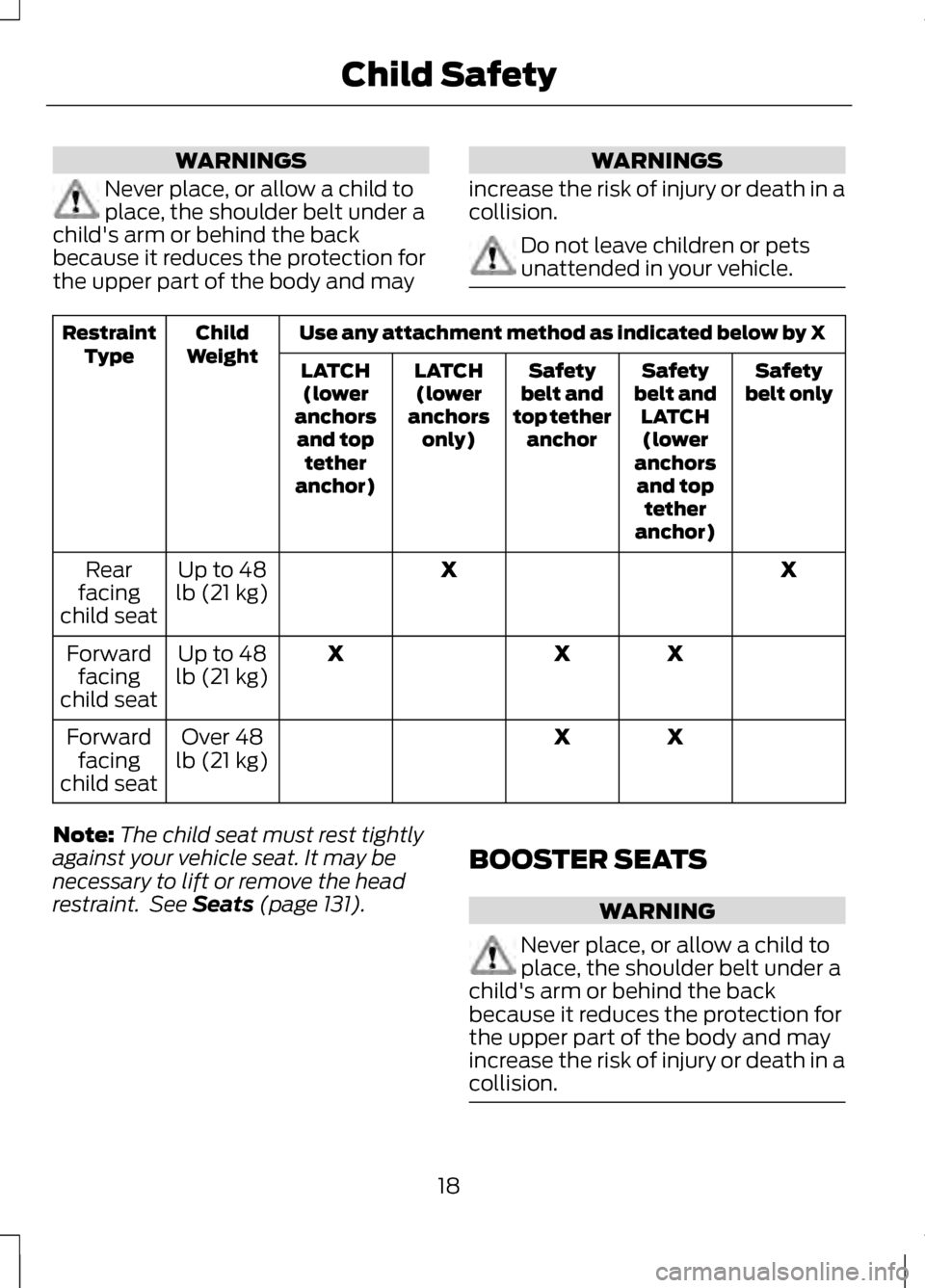
WARNINGS
Never place, or allow a child to
place, the shoulder belt under a
child's arm or behind the back
because it reduces the protection for
the upper part of the body and may WARNINGS
increase the risk of injury or death in a
collision. Do not leave children or pets
unattended in your vehicle.
Use any attachment method as indicated below by X
Child
Weight
Restraint
Type Safety
belt only
Safety
belt and LATCH(lower
anchors and top tether
anchor)
Safety
belt and
top tether anchor
LATCH
(lower
anchors only)
LATCH
(lower
anchors and top tether
anchor)
X
X
Up to 48
lb (21 kg)
Rear
facing
child seat
X
X
X
Up to 48
lb (21 kg)
Forward
facing
child seat
X
X
Over 48
lb (21 kg)
Forward
facing
child seat
Note: The child seat must rest tightly
against your vehicle seat. It may be
necessary to lift or remove the head
restraint. See Seats (page 131). BOOSTER SEATS WARNING
Never place, or allow a child to
place, the shoulder belt under a
child's arm or behind the back
because it reduces the protection for
the upper part of the body and may
increase the risk of injury or death in a
collision. 18
Child Safety
Page 22 of 474
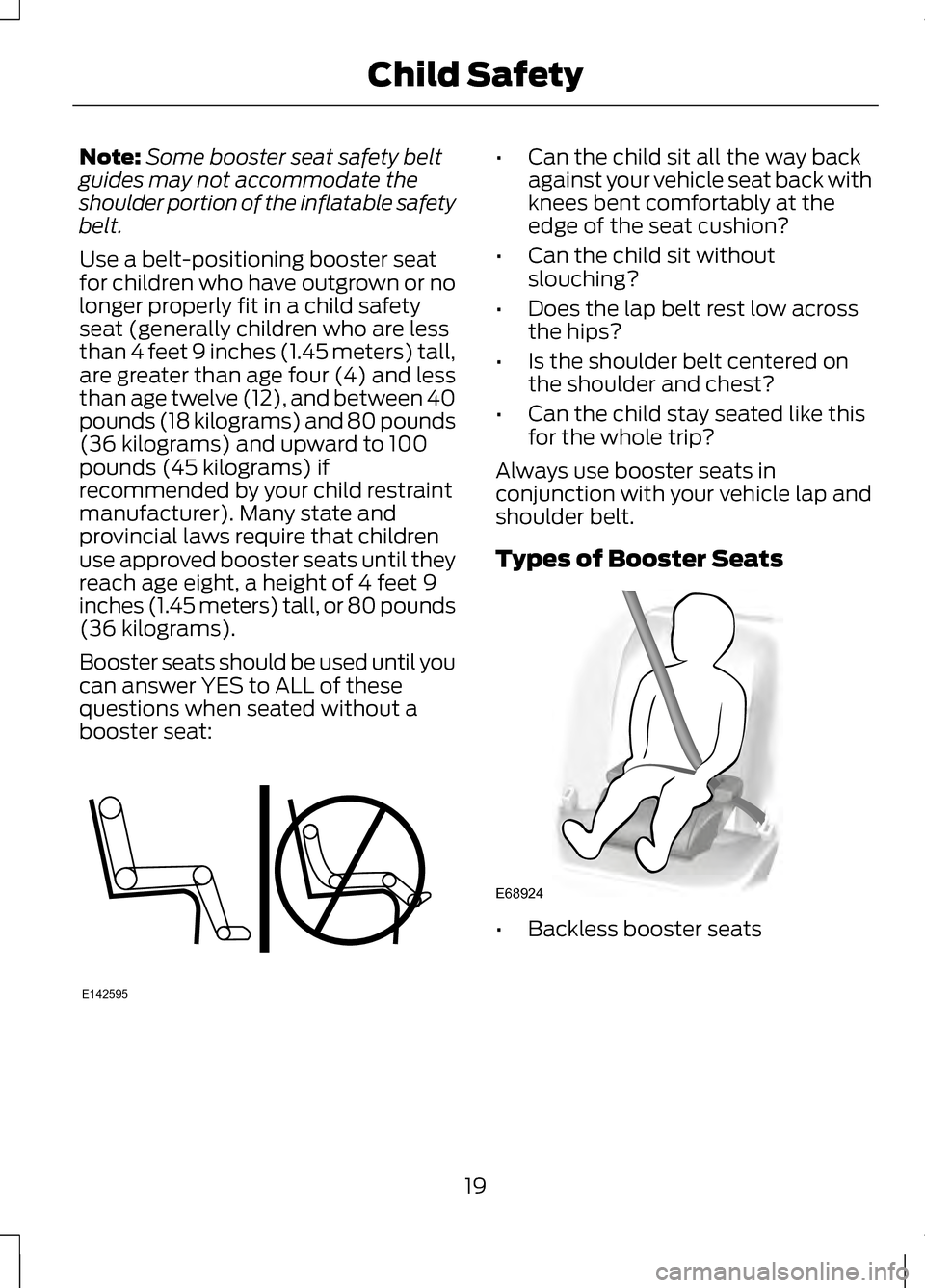
Note:
Some booster seat safety belt
guides may not accommodate the
shoulder portion of the inflatable safety
belt.
Use a belt-positioning booster seat
for children who have outgrown or no
longer properly fit in a child safety
seat (generally children who are less
than 4 feet 9 inches (1.45 meters) tall,
are greater than age four (4) and less
than age twelve (12), and between 40
pounds (18 kilograms) and 80 pounds
(36 kilograms) and upward to 100
pounds (45 kilograms) if
recommended by your child restraint
manufacturer). Many state and
provincial laws require that children
use approved booster seats until they
reach age eight, a height of 4 feet 9
inches (1.45 meters) tall, or 80 pounds
(36 kilograms).
Booster seats should be used until you
can answer YES to ALL of these
questions when seated without a
booster seat: •
Can the child sit all the way back
against your vehicle seat back with
knees bent comfortably at the
edge of the seat cushion?
• Can the child sit without
slouching?
• Does the lap belt rest low across
the hips?
• Is the shoulder belt centered on
the shoulder and chest?
• Can the child stay seated like this
for the whole trip?
Always use booster seats in
conjunction with your vehicle lap and
shoulder belt.
Types of Booster Seats •
Backless booster seats
19
Child SafetyE142595 E68924
Page 23 of 474
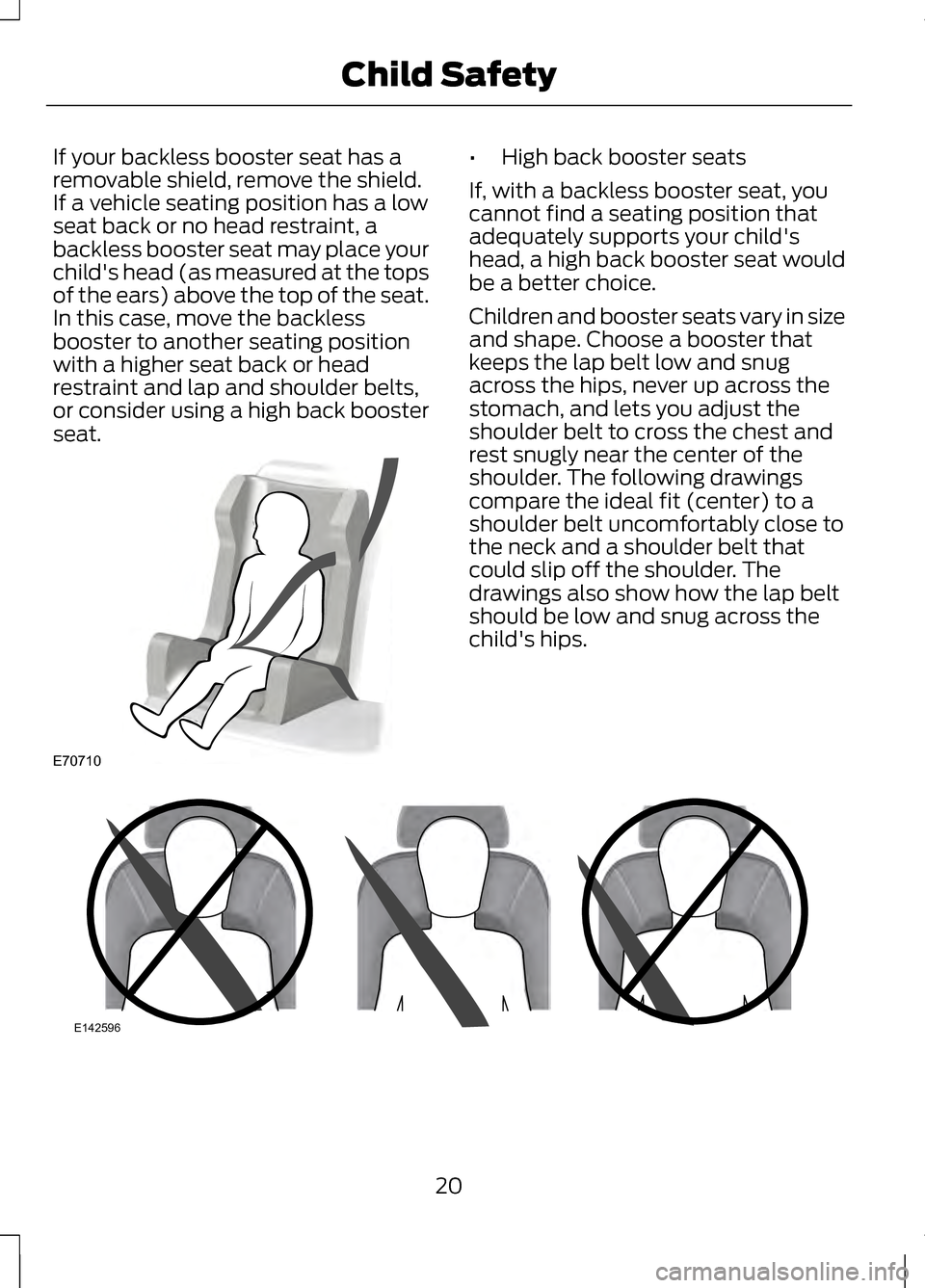
If your backless booster seat has a
removable shield, remove the shield.
If a vehicle seating position has a low
seat back or no head restraint, a
backless booster seat may place your
child's head (as measured at the tops
of the ears) above the top of the seat.
In this case, move the backless
booster to another seating position
with a higher seat back or head
restraint and lap and shoulder belts,
or consider using a high back booster
seat. •
High back booster seats
If, with a backless booster seat, you
cannot find a seating position that
adequately supports your child's
head, a high back booster seat would
be a better choice.
Children and booster seats vary in size
and shape. Choose a booster that
keeps the lap belt low and snug
across the hips, never up across the
stomach, and lets you adjust the
shoulder belt to cross the chest and
rest snugly near the center of the
shoulder. The following drawings
compare the ideal fit (center) to a
shoulder belt uncomfortably close to
the neck and a shoulder belt that
could slip off the shoulder. The
drawings also show how the lap belt
should be low and snug across the
child's hips. 20
Child SafetyE70710 E142596
Page 24 of 474
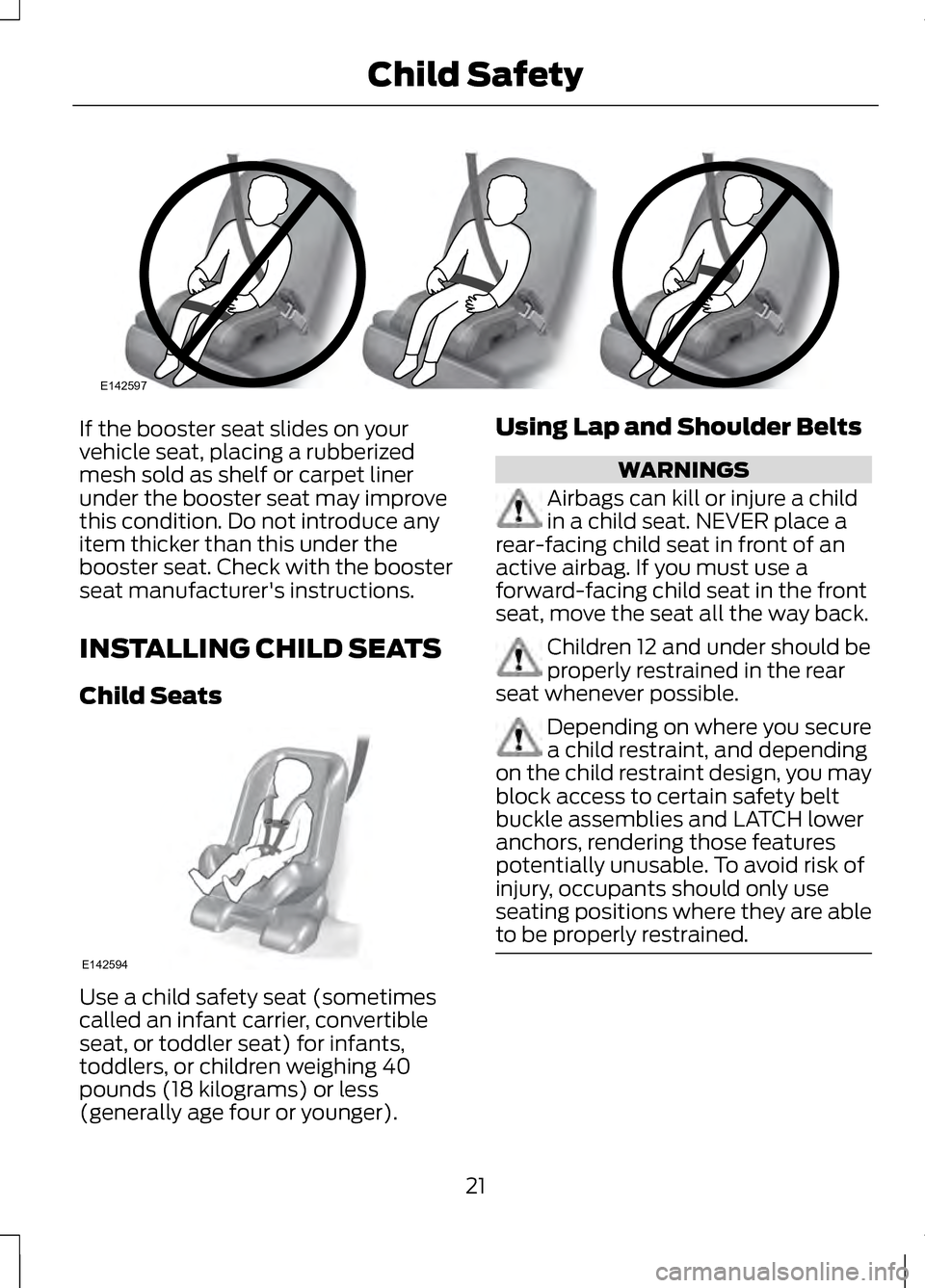
If the booster seat slides on your
vehicle seat, placing a rubberized
mesh sold as shelf or carpet liner
under the booster seat may improve
this condition. Do not introduce any
item thicker than this under the
booster seat. Check with the booster
seat manufacturer's instructions.
INSTALLING CHILD SEATS
Child Seats
Use a child safety seat (sometimes
called an infant carrier, convertible
seat, or toddler seat) for infants,
toddlers, or children weighing 40
pounds (18 kilograms) or less
(generally age four or younger). Using Lap and Shoulder Belts WARNINGS
Airbags can kill or injure a child
in a child seat. NEVER place a
rear-facing child seat in front of an
active airbag. If you must use a
forward-facing child seat in the front
seat, move the seat all the way back. Children 12 and under should be
properly restrained in the rear
seat whenever possible. Depending on where you secure
a child restraint, and depending
on the child restraint design, you may
block access to certain safety belt
buckle assemblies and LATCH lower
anchors, rendering those features
potentially unusable. To avoid risk of
injury, occupants should only use
seating positions where they are able
to be properly restrained. 21
Child SafetyE142597 E142594
Page 25 of 474
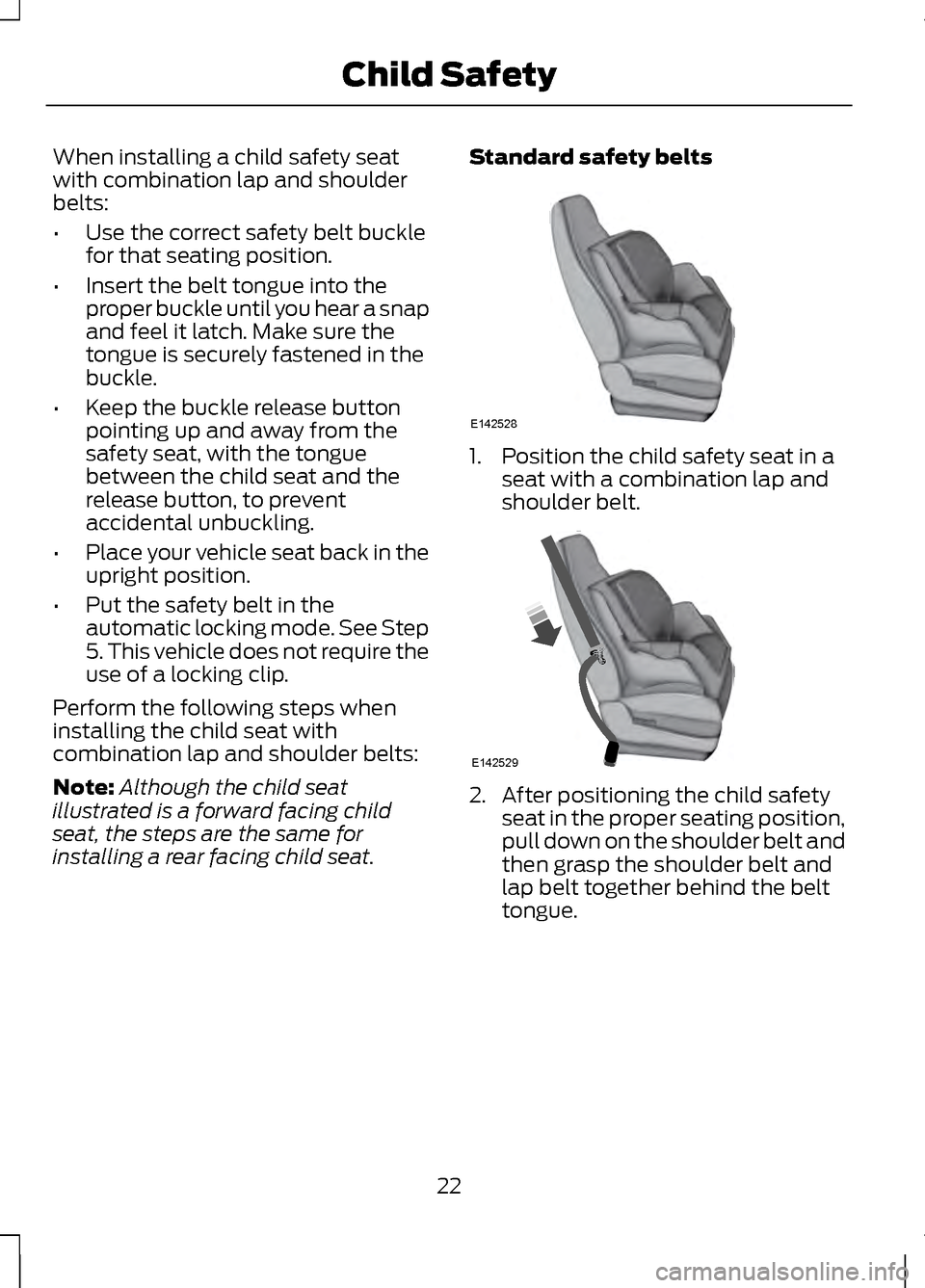
When installing a child safety seat
with combination lap and shoulder
belts:
•
Use the correct safety belt buckle
for that seating position.
• Insert the belt tongue into the
proper buckle until you hear a snap
and feel it latch. Make sure the
tongue is securely fastened in the
buckle.
• Keep the buckle release button
pointing up and away from the
safety seat, with the tongue
between the child seat and the
release button, to prevent
accidental unbuckling.
• Place your vehicle seat back in the
upright position.
• Put the safety belt in the
automatic locking mode. See Step
5. This vehicle does not require the
use of a locking clip.
Perform the following steps when
installing the child seat with
combination lap and shoulder belts:
Note: Although the child seat
illustrated is a forward facing child
seat, the steps are the same for
installing a rear facing child seat. Standard safety belts 1. Position the child safety seat in a
seat with a combination lap and
shoulder belt. 2. After positioning the child safety
seat in the proper seating position,
pull down on the shoulder belt and
then grasp the shoulder belt and
lap belt together behind the belt
tongue.
22
Child SafetyE142528 E142529
Page 26 of 474
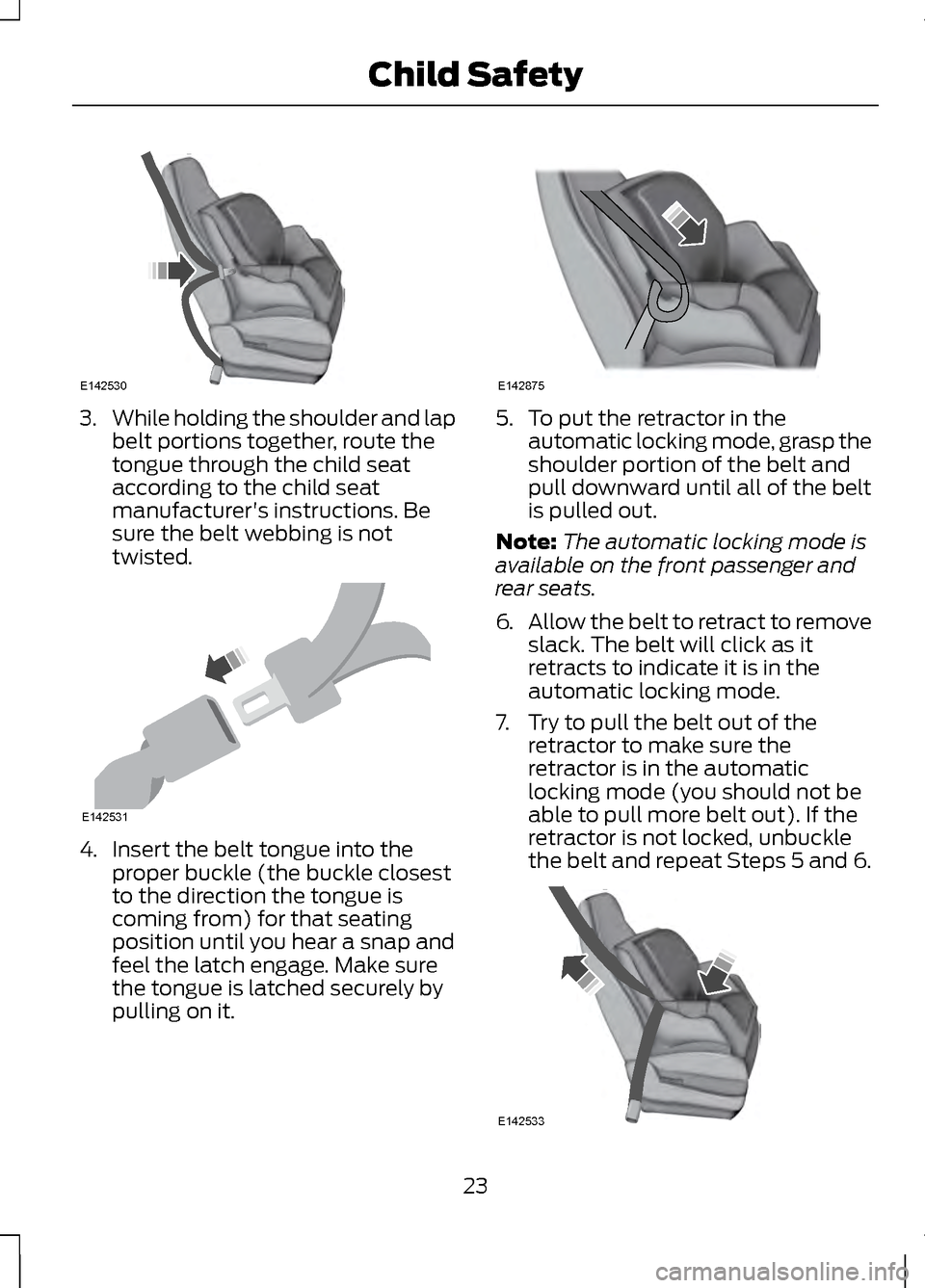
3.
While holding the shoulder and lap
belt portions together, route the
tongue through the child seat
according to the child seat
manufacturer's instructions. Be
sure the belt webbing is not
twisted. 4. Insert the belt tongue into the
proper buckle (the buckle closest
to the direction the tongue is
coming from) for that seating
position until you hear a snap and
feel the latch engage. Make sure
the tongue is latched securely by
pulling on it. 5. To put the retractor in the
automatic locking mode, grasp the
shoulder portion of the belt and
pull downward until all of the belt
is pulled out.
Note: The automatic locking mode is
available on the front passenger and
rear seats.
6. Allow the belt to retract to remove
slack. The belt will click as it
retracts to indicate it is in the
automatic locking mode.
7. Try to pull the belt out of the retractor to make sure the
retractor is in the automatic
locking mode (you should not be
able to pull more belt out). If the
retractor is not locked, unbuckle
the belt and repeat Steps 5 and 6. 23
Child SafetyE142530 E142531 E142875 E142533
Page 27 of 474
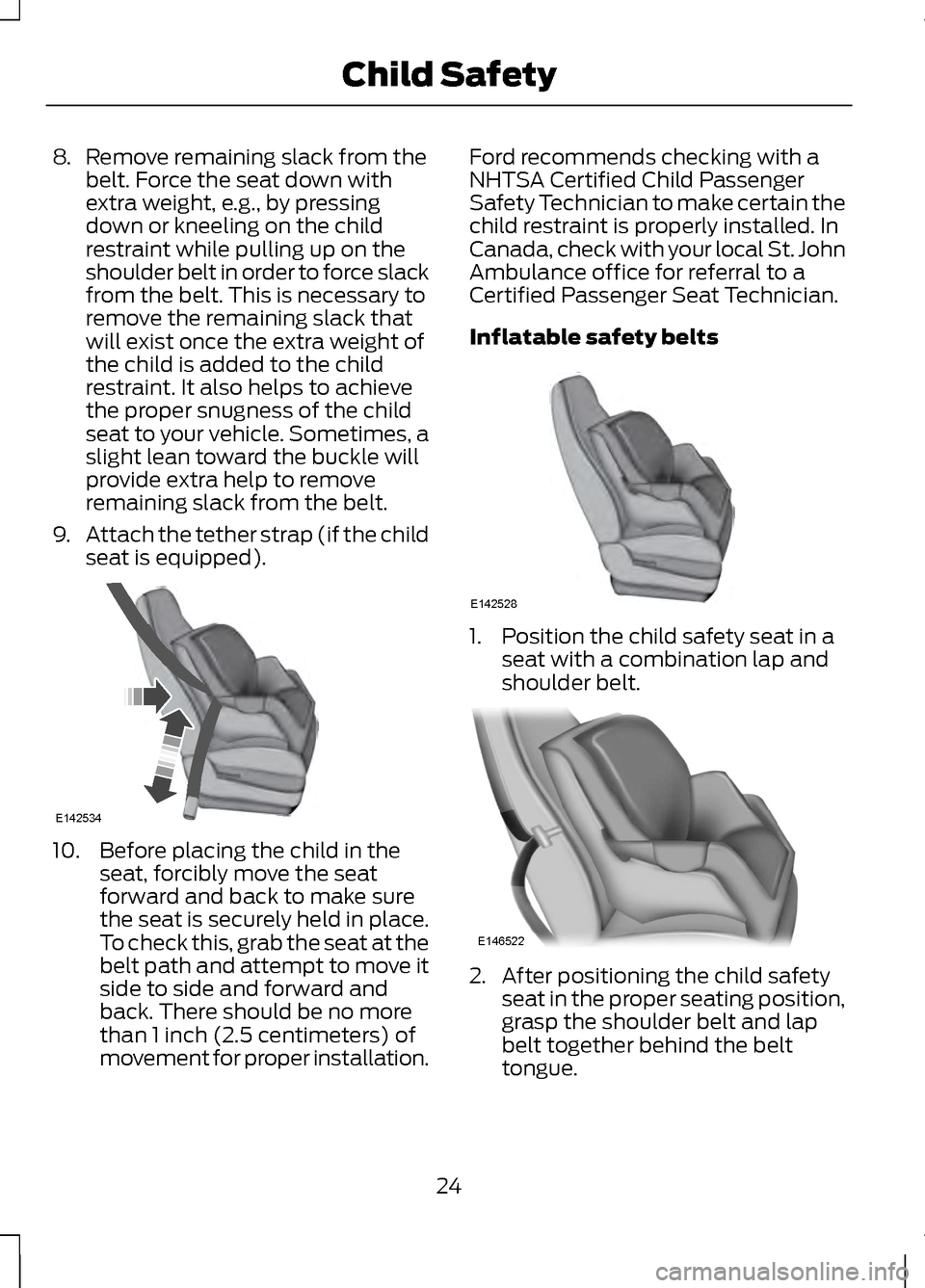
8.
Remove remaining slack from the
belt. Force the seat down with
extra weight, e.g., by pressing
down or kneeling on the child
restraint while pulling up on the
shoulder belt in order to force slack
from the belt. This is necessary to
remove the remaining slack that
will exist once the extra weight of
the child is added to the child
restraint. It also helps to achieve
the proper snugness of the child
seat to your vehicle. Sometimes, a
slight lean toward the buckle will
provide extra help to remove
remaining slack from the belt.
9. Attach the tether strap (if the child
seat is equipped). 10. Before placing the child in the
seat, forcibly move the seat
forward and back to make sure
the seat is securely held in place.
To check this, grab the seat at the
belt path and attempt to move it
side to side and forward and
back. There should be no more
than 1 inch (2.5 centimeters) of
movement for proper installation. Ford recommends checking with a
NHTSA Certified Child Passenger
Safety Technician to make certain the
child restraint is properly installed. In
Canada, check with your local St. John
Ambulance office for referral to a
Certified Passenger Seat Technician.
Inflatable safety belts
1. Position the child safety seat in a
seat with a combination lap and
shoulder belt. 2. After positioning the child safety
seat in the proper seating position,
grasp the shoulder belt and lap
belt together behind the belt
tongue.
24
Child SafetyE142534 E142528 E146522
Page 28 of 474
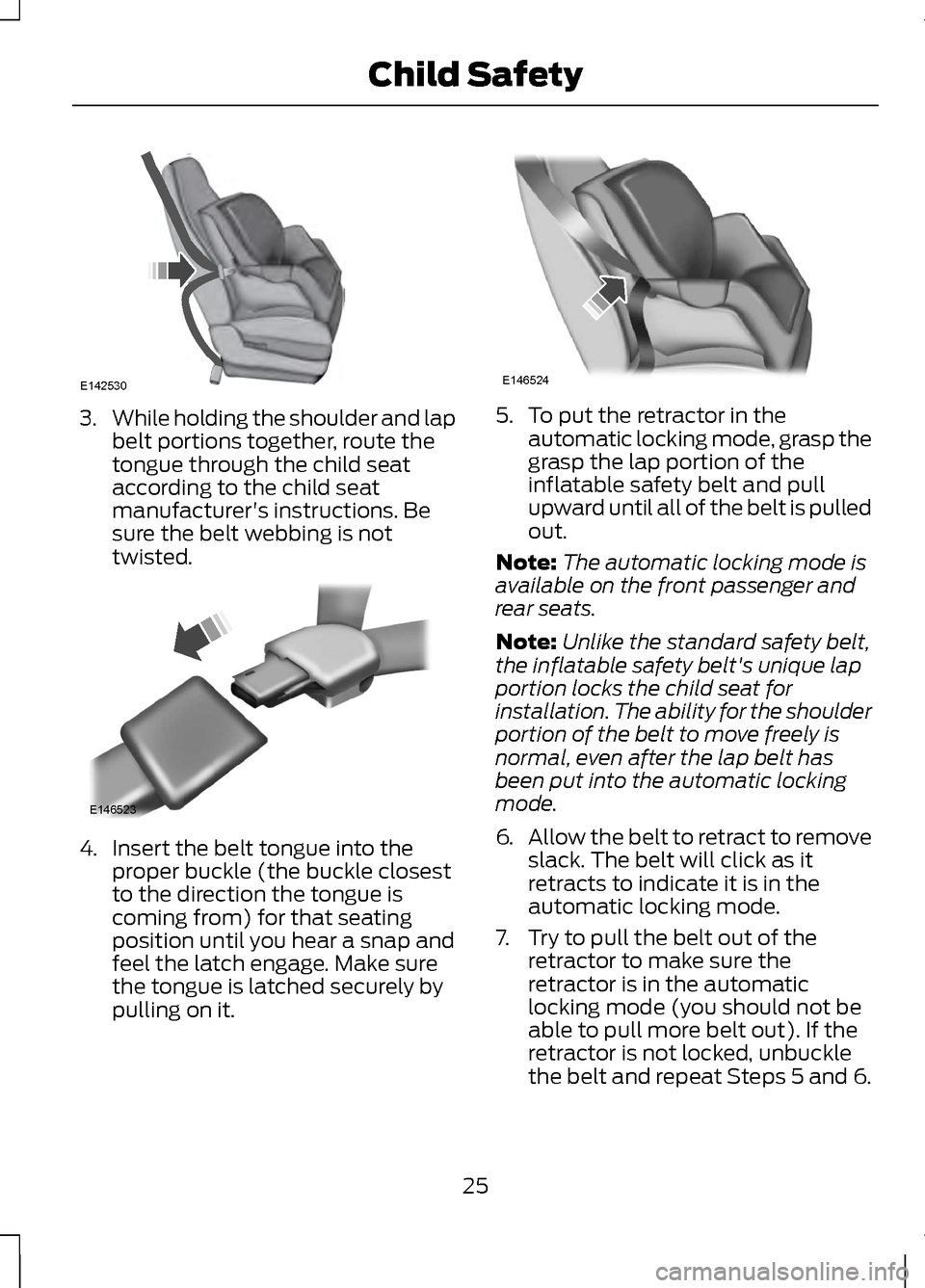
3.
While holding the shoulder and lap
belt portions together, route the
tongue through the child seat
according to the child seat
manufacturer's instructions. Be
sure the belt webbing is not
twisted. 4. Insert the belt tongue into the
proper buckle (the buckle closest
to the direction the tongue is
coming from) for that seating
position until you hear a snap and
feel the latch engage. Make sure
the tongue is latched securely by
pulling on it. 5. To put the retractor in the
automatic locking mode, grasp the
grasp the lap portion of the
inflatable safety belt and pull
upward until all of the belt is pulled
out.
Note: The automatic locking mode is
available on the front passenger and
rear seats.
Note: Unlike the standard safety belt,
the inflatable safety belt's unique lap
portion locks the child seat for
installation. The ability for the shoulder
portion of the belt to move freely is
normal, even after the lap belt has
been put into the automatic locking
mode.
6. Allow the belt to retract to remove
slack. The belt will click as it
retracts to indicate it is in the
automatic locking mode.
7. Try to pull the belt out of the retractor to make sure the
retractor is in the automatic
locking mode (you should not be
able to pull more belt out). If the
retractor is not locked, unbuckle
the belt and repeat Steps 5 and 6.
25
Child SafetyE142530 E146523 E146524
Page 29 of 474
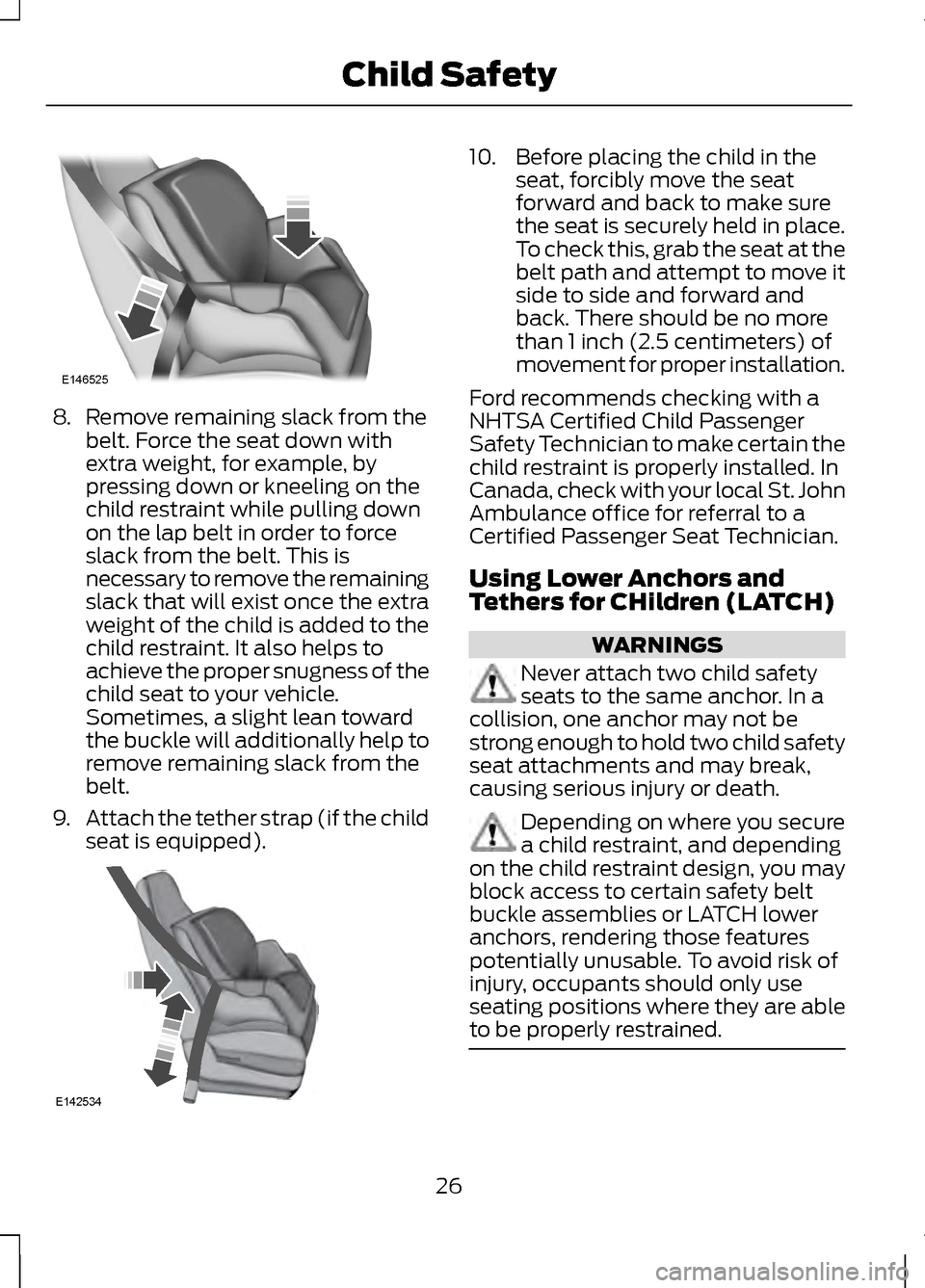
8.
Remove remaining slack from the
belt. Force the seat down with
extra weight, for example, by
pressing down or kneeling on the
child restraint while pulling down
on the lap belt in order to force
slack from the belt. This is
necessary to remove the remaining
slack that will exist once the extra
weight of the child is added to the
child restraint. It also helps to
achieve the proper snugness of the
child seat to your vehicle.
Sometimes, a slight lean toward
the buckle will additionally help to
remove remaining slack from the
belt.
9. Attach the tether strap (if the child
seat is equipped). 10. Before placing the child in the
seat, forcibly move the seat
forward and back to make sure
the seat is securely held in place.
To check this, grab the seat at the
belt path and attempt to move it
side to side and forward and
back. There should be no more
than 1 inch (2.5 centimeters) of
movement for proper installation.
Ford recommends checking with a
NHTSA Certified Child Passenger
Safety Technician to make certain the
child restraint is properly installed. In
Canada, check with your local St. John
Ambulance office for referral to a
Certified Passenger Seat Technician.
Using Lower Anchors and
Tethers for CHildren (LATCH) WARNINGS
Never attach two child safety
seats to the same anchor. In a
collision, one anchor may not be
strong enough to hold two child safety
seat attachments and may break,
causing serious injury or death. Depending on where you secure
a child restraint, and depending
on the child restraint design, you may
block access to certain safety belt
buckle assemblies or LATCH lower
anchors, rendering those features
potentially unusable. To avoid risk of
injury, occupants should only use
seating positions where they are able
to be properly restrained. 26
Child SafetyE146525 E142534
Page 30 of 474
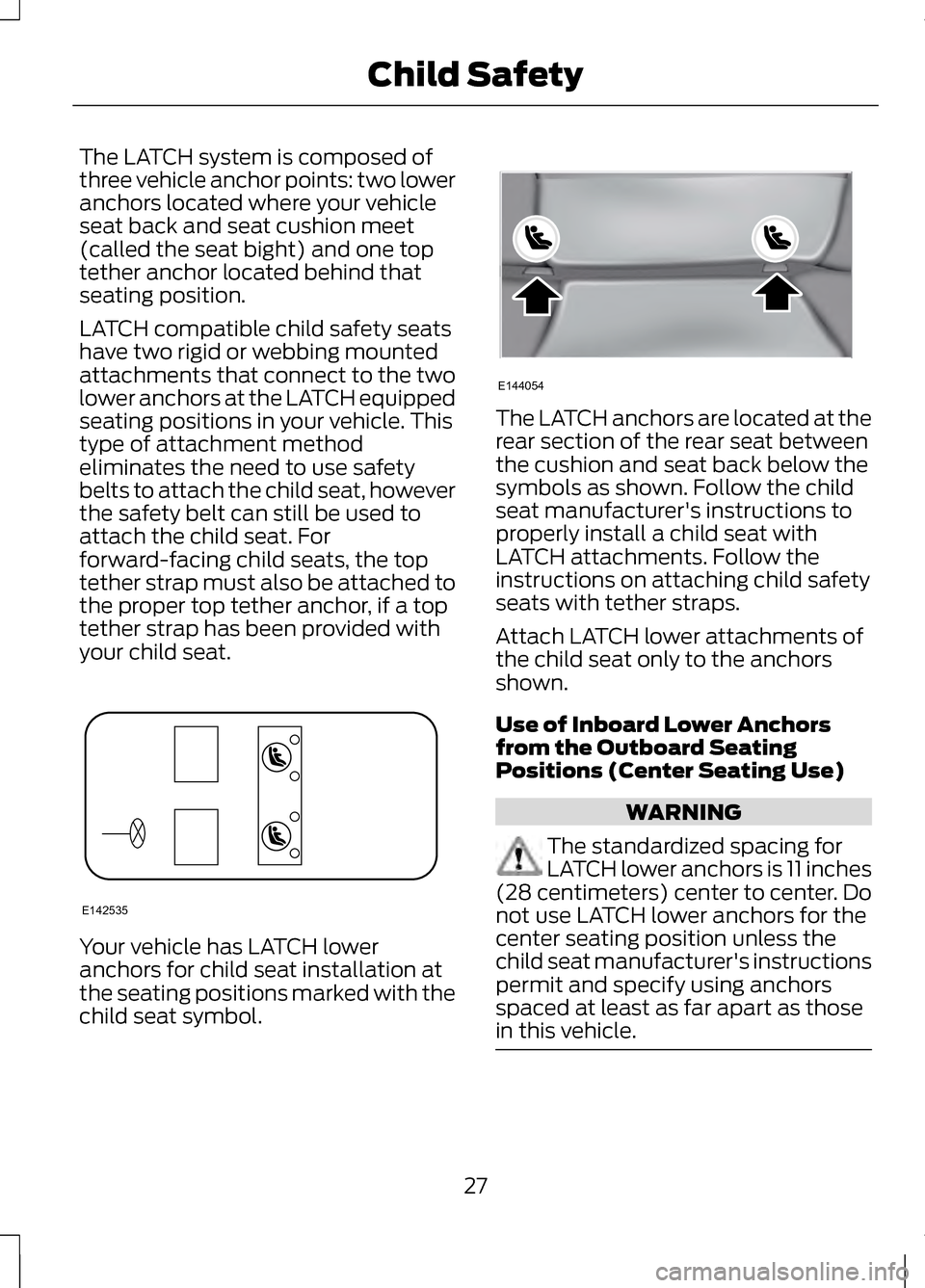
The LATCH system is composed of
three vehicle anchor points: two lower
anchors located where your vehicle
seat back and seat cushion meet
(called the seat bight) and one top
tether anchor located behind that
seating position.
LATCH compatible child safety seats
have two rigid or webbing mounted
attachments that connect to the two
lower anchors at the LATCH equipped
seating positions in your vehicle. This
type of attachment method
eliminates the need to use safety
belts to attach the child seat, however
the safety belt can still be used to
attach the child seat. For
forward-facing child seats, the top
tether strap must also be attached to
the proper top tether anchor, if a top
tether strap has been provided with
your child seat.
Your vehicle has LATCH lower
anchors for child seat installation at
the seating positions marked with the
child seat symbol. The LATCH anchors are located at the
rear section of the rear seat between
the cushion and seat back below the
symbols as shown. Follow the child
seat manufacturer's instructions to
properly install a child seat with
LATCH attachments. Follow the
instructions on attaching child safety
seats with tether straps.
Attach LATCH lower attachments of
the child seat only to the anchors
shown.
Use of Inboard Lower Anchors
from the Outboard Seating
Positions (Center Seating Use)
WARNING
The standardized spacing for
LATCH lower anchors is 11 inches
(28 centimeters) center to center. Do
not use LATCH lower anchors for the
center seating position unless the
child seat manufacturer's instructions
permit and specify using anchors
spaced at least as far apart as those
in this vehicle. 27
Child SafetyE142535 E144054